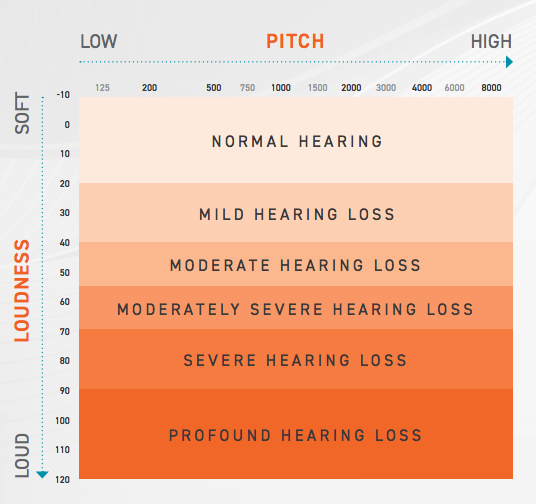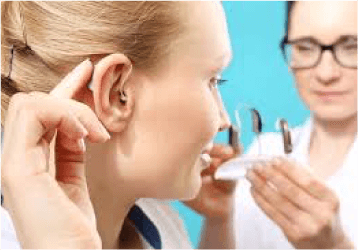What to expect at the hearing clinic
It’s time to get your hearing assessed. You’ve noticed your hearing is not as sharp as it was in your twenties and it’s time to do something about it, to ensure your mind stays active and you don’t drift into social isolation. Now is the time to act! You may be curious to know what will happen at each appointment, so let’s look at each one in detail.
The hearing assessment appointment
Your clinician (either an Audiologist or Audiometrist) will firstly ask you a series of questions about your hearing health, your medical history and the situations where you’re having communication difficulties. They will then look in your ears with an otoscope to check your ear canals are clear. If wax removal is required, they’ll let you know.
Now it’s time for the hearing test. Some clinics will begin by carrying out a test of your middle ear function (not all clinics do this). This is a relatively quick test where a probe is placed in the entrance to your ear canal and you will feel a pressure change in your ears as the tympanometer measures the mobility of your middle ear system. You may also hear some quite loud beeps during this assessment. Please note, that this is not a test of your hearing and you do not have to respond in any way.
The clinician will probably ask you to sit still and not to speak throughout this test. Once this test is completed you will be set up for the audiometry assessment. At this stage you may be asked to step into a sound proof booth (not all clinics have one). If you’re claustrophobic, let your clinician know and they will leave the door open for you.
Now a set of headphones will be placed on your head (or insert earphones placed in your ear canals) and you’ll be given a response button. You’ll be asked to press the button whenever you hear a tone, no matter how soft. You’re being assessed for your threshold of hearing, that is, where you just hear a sound. You’ll hear different pitches or frequencies of sound and your ears will be tested separately. This is the first part of audiometry and is called ‘air conduction’.
The headphones (or earphones) are then removed and the ‘bone conductor’ placed behind one of your ears.

This is a tight headphone with a black vibrating box (the piece behind your ear). As before, you’ll respond to all the tones you hear by pressing a button. For some people, once ‘bone conduction’ is finished, the hearing test is complete, but for others, a little more testing is required where they hear rushing sounds along with the tones. Once all the audiometry components are completed, the clinician will then carry out speech testing. You’ll be instructed to listen to single words and repeat them back. The words will be at a few different levels – easy to hear, louder and softer. The clinician records your responses and then the testing is finished.
Your clinician will then explain your results and discuss with you a number of options:
- If your hearing is normal, come back for a retest every 12 months (just like you do with your eye test)
- If you have a medical issue with your ears you’ll be referred to your doctor
- If you have a hearing loss that can’t be medically treated, a hearing device will be recommended.
At this stage you may want to go away and think about the results, or get a second opinion – and that’s fine. Otherwise you may be ready to discuss hearing devices and in some clinics you can actually be fitted with a trial device there and then.
Hearing device discussion
You may already have clear ideas of the type of hearing device you want. Discuss this with your clinician to see if your hearing is appropriate for the hearing aid you want. Every hearing loss, every ear, is different so have an open mind and listen to the clinician if they think the one you’ve suggested won’t suit you. For example, if you want an invisible hearing aid in the ear canal, but are prone to wax build up or ear infections, your clinician may suggest an alternative.
The clinician will discuss with you your lifestyle – how active you are, what your communication needs are, if you want to stream phone calls, if you want rechargeable batteries and how much you want to pay.

Together you will make the decision on the brand, model and style of hearing aid. At this stage, if an impression of your ear is required, the clinician will take the impression and send it off to be made up. Your hearing aid will be ordered and a fitting appointment organised. However, your clinician may also offer you a trial hearing aid and you can be fitted and walk out the door with your hearing aid, ready to go!
The hearing aid fitting appointment
It’s a good idea to bring a support person to your hearing aid fitting. There’s a lot to take in and sometimes it’s better to have a second pair of ears listening, just in case you forget something. There are a couple of things that must happen in this appointment – so don’t leave the appointment until you are comfortable with the following:
- How the to put the hearing aid in easily
- How the hearing aid sounds (not too loud, or too tinny, or you just don’t like the sound of it) and feels in your ear – is shouldn’t be uncomfortable or hurt any section of your ear.
- How to clean and maintain your hearing aid
- How to change the battery or charge the hearing aid with the rechargeable battery.

The clinician will also run a few checks on the hearing aid. Firstly they’ll carry out ‘real ear’ measurements. This is where they check that the hearing aid is working in your ear to the prescribed specifications. This doesn’t take long and the clinician may make some adjustments to the hearing aid, to ensure you’re comfortable with the sound of the aid. The clinician should also do some quick speech tests, with and without your hearing aids on, so you can see the difference in your hearing with the hearing aids on. You’ll also be given a ‘listening program’ so you know where and when to start using your hearing aids. Some listening situations are tougher than others and you may wish to build up to these. However the more you use your hearing aids, the quicker you’ll acclimatise to them. You may love them so much from the get go, you won’t want to take them off!
If you’ve chosen a hearing aid that uses an app on your smartphone, then, time permitting, the clinician should show you how to set this up and use the controls. This may be left to the follow up appointment but if this is important to you, make sure you let the clinician know you want it set up from the start.
Before you leave the fitting appointment, check once again you’re comfortable with putting your hearing aid in and removing it and ask any questions you may have. You’ll probably be provided with a written outline of what was covered in the fitting appointment in case you forget something. And the last thing you should do is arrange your follow up appointment where the clinician can check how you’re going and you can bring up any issues you’ve had. It’s not often a first fit is perfect so write down any problems you have in the first week or so and bring them up at your follow up appointment to ensure they get attended to. If you’re not happy with any aspect of your hearing aid, you must tell your clinician. They want your hearing journey to be successful as much as you do.
